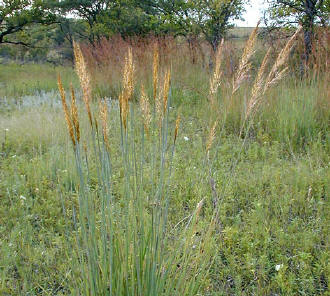 (5/23) As summer approaches, maybe like me, you are surveying your yard and deciding to take up a gardenerís challenge to beautify a pesky area that mars your landscape. Maybe, thereís a particularly dry sunny spot in the lawn where turf grass just doesnít want to grow. Or, thereís that part of your yard that tends to get intermittently flooded and boldly stares at you when itís dry. Or, youíd just like a little more privacy on your propertyónothing too dense to shade you in, but something to serve as a pretty screen from street view.
(5/23) As summer approaches, maybe like me, you are surveying your yard and deciding to take up a gardenerís challenge to beautify a pesky area that mars your landscape. Maybe, thereís a particularly dry sunny spot in the lawn where turf grass just doesnít want to grow. Or, thereís that part of your yard that tends to get intermittently flooded and boldly stares at you when itís dry. Or, youíd just like a little more privacy on your propertyónothing too dense to shade you in, but something to serve as a pretty screen from street view.
A good, and perhaps, surprising option to such varied problems are ornamental warm season native grasses. These bunch grasses are perennials that put out stately growth every summer. Resilient in a variety of soil and environmental conditions, they pack a punch in helping solve unsightly landscape problems.
Master gardeners highlight the "big four" of warm season native grasses for their winsome potential. These are Big Bluestem (Andropogon gerardii), Little Bluestem (Schizachyrium scoparium), Switchgrass (Panicum virgatum) and Indiangrass (Sorghastrum nutans). Best recognized as the beautiful swaying grasses of Americaís prairielands, each of these grasses has a native range that extends into Pennsylvania. They have co-evolved over millennia to support our continentís remarkable local flora and fauna, from the majestic American bison to a host of insects, including the Arogos Skipper (Atrytone arogos) a critically endangered butterfly species in the eastern U.S.
Historically, when Europeans first settled in Pennsylvania, these grasses were a staple in meadows that existed within an otherwise mostly forested landscape. Such meadows were often actively managed against woody encroachment by Native Americans who valued the open landscapes for sustaining important wildlife like turkey and grouse and who used such grasses for many cultural purposes like medicine, for example. While European settlement and industrial development have taken their toll on Native communities and related native grasslands, in pockets along the eastern U.S. today there are encouraging efforts to restore both.
Restoring the "big four" grasses offer many conservation benefits along with aesthetic ones. Adding them to your backyard can be very rewarding. Specifically, once established, these grasses are very low maintenance. No matter the soil type (sand, loam, or clay), they arenít picky. While they prefer full sun, they can do well in dappled shade. This is especially true for Big Bluestem.
With deep root systems, these grasses are very drought tolerant. Of the four, Indiangrass and Big Bluestem also survive wetland and poor drainage conditions well. Thus, if you are looking to fix that bald spot problem in your yard caused by too much dryness, any of the four offer a good solution. A site with intermittent flooding can benefit from planting Indiangrass and Big Bluestem. The deep root systems serve another important function. They provide soil stabilization and are recommended as erosion control along stream banks and hill slopes.
In appearance, these grasses grow in tall clusters of swaying stems and leaves. Big Bluestem can be five to seven feet in height, while Indiangrass and Switchgrass average four to six feet, making all three ideal for use as privacy screens. Mixing and matching these three tall grasses with the shorter Little Bluestem at two to four feet provides visual layering. Both Big and Little Bluestem, as their name suggests, have green leaves with a bluish tint. In fall, they turn a rich reddish-purple. Indiangrass also sometimes called Yellow Indiangrass, turns yellow in fall, while Switchgrass favors golden-brown.
The flower and seed heads impart a feathery texture to the plants. The flowers of the Big Bluestem form at the tip of stems to resemble a birdís three-toed foot, earning it the additional name, Turkeyfoot. With deep root systems and tall stems, these grasses often stay standing regally into the first snows of winter.
In winter, these grasses also provide hibernation shelter for queen bumble bees, the sole survivors of their hives until the following spring, when they emerge and start new colonies of pollinators. The grasses serve as host plants to the caterpillars of grass skippers (Hesperiinae), a subset of small butterflies (often with striking wing markings that look like eyes). Insects like these, as well as the grass seeds attract a variety of songbirds, like the Eastern Meadowlark (Sturnella magna). To enhance wildlife in your yard, adding in wildflowers that can thrive with your native grasses offers yet more possibilities.
Establishing all or some of the "big four" native grasses in your yard to add such aesthetic and conservation benefits is relatively straight forward. Given their tolerance for all soil types, no soil amendments are necessary during planting. However, it is best to clear the site of existing sod or weeds, as these can outcompete young native grasses before they get established. May is an ideal time to plant, as your grasses will grow over the summer months.
That said, be patient. These grasses spend energy their first few years developing their deep root systems. Once these are established, they then grow into their full height of beautiful bunches, requiring little yearly effort on your part. When well established, these grasses should out-compete weeds. Mowing, after nesting season, once every four to seven years, is all that is required to keep native grasses thriving.
Read other articles on ecological gardening & native plants
Read other articles by Salma Monani